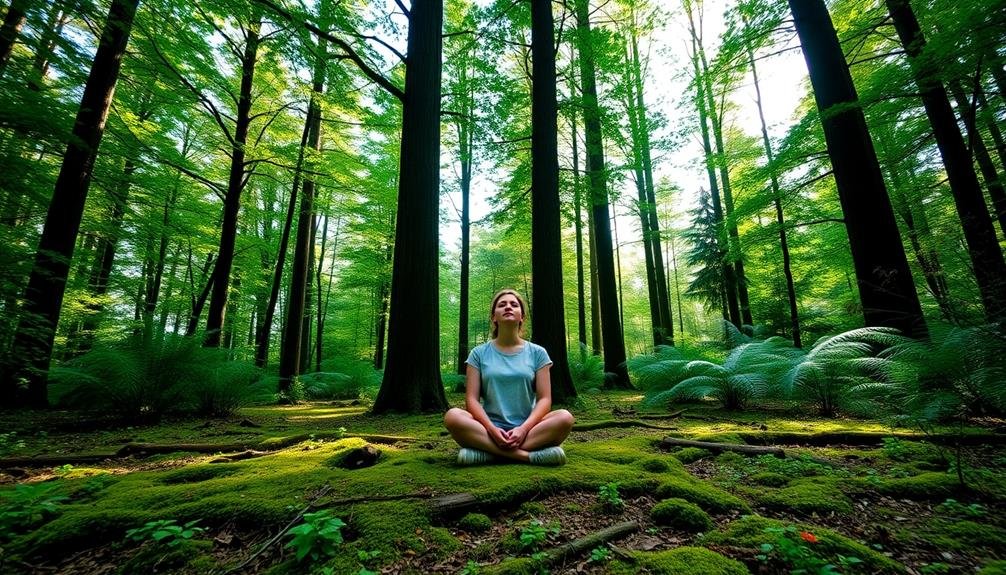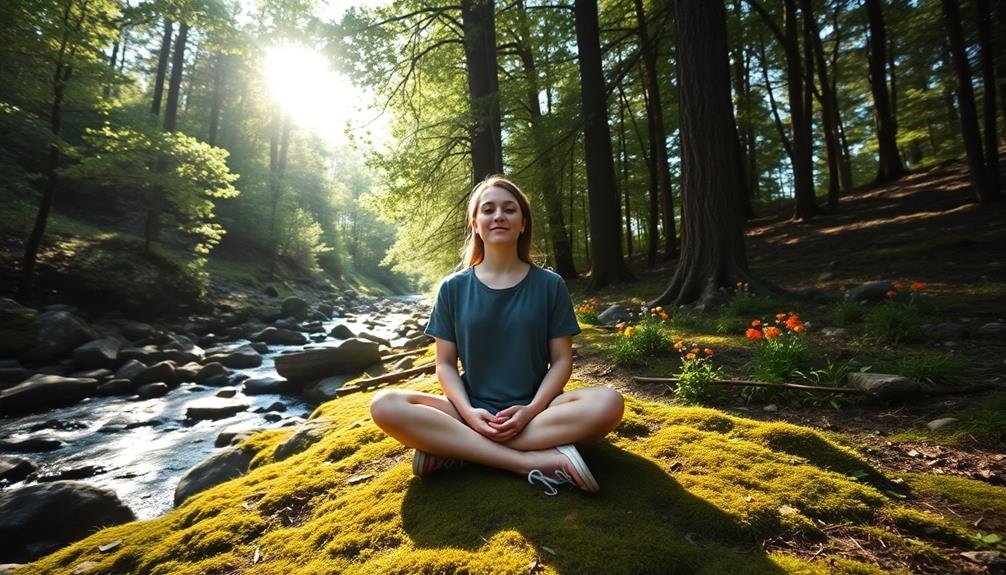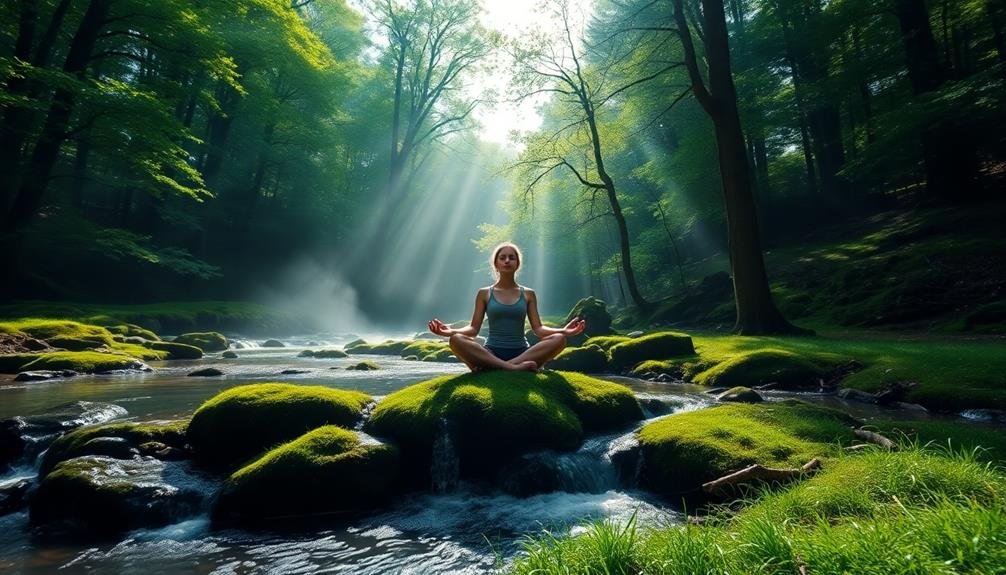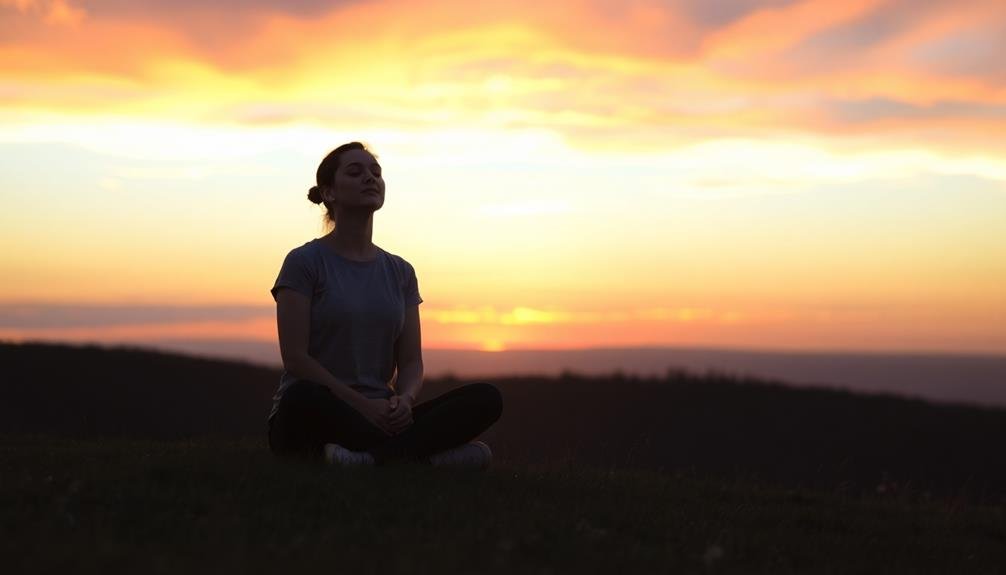Embrace nature's calming influence with these five outdoor meditation techniques to ease anxiety. Try forest bathing (shinrin-yoku) to immerse yourself in woodland serenity. Practice mindful nature walking, focusing on each step and breath. Ground yourself by connecting with earth's elements through barefoot contact and sensory engagement. Use flowing water visualization to wash away worries and cultivate adaptability. Engage in sunset sky gazing to quiet your mind and sync with nature's rhythms. Each method offers a unique way to reduce stress and promote inner peace. Discover how these practices can transform your relationship with the outdoors and your own mental well-being.
Key Takeaways
- Forest bathing immerses you in nature, engaging senses and deep breathing to reduce stress and boost immunity.
- Mindful nature walking combines meditation with outdoor exercise, focusing on each step and breath to reduce anxiety.
- Grounding with earth's elements connects you to nature through barefoot contact, water sounds, and outdoor breathing exercises.
- Flowing water visualization uses water's soothing properties to imagine worries being carried away, promoting adaptability and resilience.
- Sunset sky gazing allows for serene reflection by observing changing colors, connecting with nature's rhythms to ease anxiety.
Forest Bathing Meditation

Forest bathing meditation, also known as shinrin-yoku, is a Japanese practice that combines mindfulness with nature immersion. To try this technique, find a peaceful wooded area and engage your senses fully.
As you walk slowly through the forest, focus on the sights, sounds, smells, and textures around you. Notice the way sunlight filters through the leaves, the crunch of twigs underfoot, and the earthy scent of the forest floor.
Take deep, mindful breaths, inhaling the fresh air and phytoncides released by trees. These natural compounds can boost your immune system and reduce stress hormones.
As you continue your forest bathing session, find a comfortable spot to sit or stand. Close your eyes and listen to the rustling leaves, chirping birds, or flowing water nearby. Feel the breeze on your skin and the ground beneath your feet.
Allow thoughts to come and go without judgment, always bringing your attention back to your surroundings. Spend at least 20 minutes in this meditative state to fully experience the benefits of forest bathing.
You'll likely feel more relaxed, centered, and connected to nature afterward.
Mindful Nature Walking

Mindful nature walking takes the practice of meditation into the great outdoors. As you stroll through natural settings, you'll focus on each step, your breath, and the environment around you. This technique combines the benefits of exercise, nature exposure, and mindfulness to reduce anxiety and improve overall well-being.
To begin, choose a quiet natural area and set a comfortable pace. As you walk, pay attention to the sensation of your feet touching the ground. Notice the texture of the path beneath you and the movement of your legs and arms. Breathe deeply and rhythmically, syncing your breath with your steps if possible.
Engage your senses fully. Listen to the sounds of birds, rustling leaves, or flowing water. Observe the colors, shapes, and patterns in the landscape. Feel the temperature of the air and the breeze on your skin. Smell the earthy scents around you.
If your mind wanders, gently bring your focus back to your senses and the present moment. Practice gratitude for nature's beauty and your ability to experience it.
This mindful connection with the outdoors can help ground you, reducing stress and anxiety.
Grounding With Earth's Elements

Earth's elements offer powerful tools for grounding yourself in nature. You can connect with these elements to reduce anxiety and feel more centered.
Start with the earth itself by sitting or standing barefoot on grass, sand, or soil. This practice, known as "earthing," allows you to absorb the earth's natural energy and release built-up tension.
Water can be incredibly calming. Find a stream, lake, or ocean and focus on the sound of flowing water. You can also dip your hands or feet into cool water, allowing the sensation to anchor you in the present moment.
For fire, safely light a candle outdoors or focus on the warmth of the sun on your skin. Let the heat remind you of your inner strength and resilience.
Air is always around you, so practice deep breathing exercises outdoors. Feel the breeze on your face and imagine it carrying away your worries.
Flowing Water Visualization

Flowing water visualization often provides a powerful tool for outdoor meditation. When you're near a stream, river, or any body of water, you can harness its soothing properties to calm your mind and reduce anxiety.
Start by finding a comfortable spot where you can see and hear the water. Close your eyes and take a few deep breaths, focusing on the sound of the flowing water.
Imagine yourself as part of the water's flow. Picture your worries and stress as leaves or twigs being carried away by the current. As you visualize this, feel the tension leaving your body. You're not fighting against the stream; instead, you're moving with it effortlessly.
Next, open your eyes and observe the water's movement. Notice how it adapts to obstacles, finding new paths around rocks or fallen branches. This adaptability serves as a metaphor for life's challenges. Like the water, you can learn to flow around obstacles rather than becoming stuck.
As you conclude this meditation, carry the feeling of fluidity with you. Remember that like water, you have the power to be both gentle and strong, adapting to life's ever-changing landscape.
Sunset Sky Gazing Practice

As the day winds down, sunset sky gazing offers a serene and visually enchanting meditation practice. To begin, find a comfortable spot outdoors with an unobstructed view of the western sky. Settle into a relaxed position, either sitting or standing, and take a few deep breaths to center yourself.
Focus your gaze on the changing colors of the sky as the sun descends. Notice the warm hues of orange, pink, and purple that paint the horizon. Don't strain your eyes; instead, let your vision soften and take in the entire panorama.
As you observe the gradual shift in light, pay attention to how the clouds transform and the stars begin to emerge. Allow your mind to quiet as you immerse yourself in the beauty of the sunset. If thoughts arise, acknowledge them without judgment and gently return your focus to the sky.
You can use the changing colors as a visual anchor for your attention. As darkness falls, you'll naturally evolve into a state of calm reflection. This practice helps you connect with nature's rhythms, easing anxiety and promoting a sense of peace as you close your day.
Frequently Asked Questions
How Can I Protect Myself From Insects During Outdoor Meditation?
You can protect yourself from insects while outdoors by using insect repellent, wearing long sleeves and pants, avoiding scented products, and choosing a spot away from standing water. You'll also benefit from bringing a light blanket or mat.
What Should I Wear for Comfortable Outdoor Meditation Sessions?
You'll want to wear loose, breathable clothing that allows for easy movement. Choose layers to adapt to changing temperatures. Comfortable shoes or sandals are essential. Don't forget a hat and sunglasses for sun protection if needed.
Are There Specific Times of Day Best for Outdoor Meditation?
You'll find early morning and late afternoon ideal for outdoor meditation. Sunrise and sunset offer serene atmospheres and comfortable temperatures. However, any time that fits your schedule and allows you to relax consistently can work well.
How Can I Incorporate Technology Into My Outdoor Meditation Practice?
You can use meditation apps for guided sessions or nature sounds. Try wearable devices to track your heart rate and breathing. Use a timer app to set session lengths. Don't forget to silence notifications to minimize distractions.
Can Outdoor Meditation Be Effective in Urban Environments With Limited Green Spaces?
Yes, you can meditate effectively in urban environments. Find quiet spots like parks, rooftops, or courtyards. Focus on natural elements like trees or sky. Use noise-canceling headphones if needed. Embrace urban sounds as part of your practice.
In Summary
You've now explored five powerful outdoor meditation techniques to calm your anxious mind. By immersing yourself in nature, you're tapping into a natural source of healing and peace. Whether you're forest bathing, walking mindfully, grounding with earth's elements, visualizing flowing water, or gazing at the sunset sky, you're giving yourself a precious gift. Remember, these practices are always available to you. Next time anxiety strikes, step outside and let nature be your guide to inner tranquility.





Leave a Reply